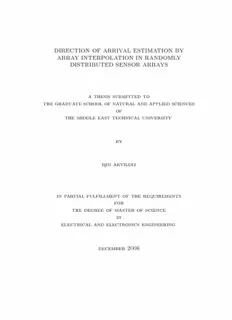
DIRECTION OF ARRIVAL ESTIMATION BY ARRAY INTERPOLATION IN RANDOMLY ... PDF
Preview DIRECTION OF ARRIVAL ESTIMATION BY ARRAY INTERPOLATION IN RANDOMLY ...
DIRECTION OF ARRIVAL ESTIMATION BY ARRAY INTERPOLATION IN RANDOMLY DISTRIBUTED SENSOR ARRAYS a thesis submitted to the graduate school of natural and applied sciences of the middle east technical university by i¸sin akyildiz in partial fulfillment of the requirements for the degree of master of science in electrical and electronics engineering december 2006 Approval of the Graduate School of Natural and Applied Sciences ¨ Prof. Dr. Canan OZGEN Director Icertifythatthisthesissatisfiesalltherequirementsasathesisforthedegree of Master of Science. ˙ Prof. Dr. Ismet ERKMEN Head of Department This is to certify that we have read this thesis and that in our opinion it is fully adequate, in scope and quality, as a thesis for the degree of Master of Science. Assoc. Prof. Dr. Engin TUNCER Supervisor Examining Committee Members ˙ ˙ Prof. Dr. Kemal LEBLEBICIOGLU (METU, EEE) Assoc. Prof. Dr. Engin TUNCER (METU, EEE) ˜ Assoc. Prof. Dr. G¨ozde BOZDAGI (METU, EEE) Asst. Prof. Dr. Af¸sar SARANLI (METU, EEE) M. Sc. Aykut ARIKAN (ASELSAN) I hearby declare that all information in this document has been obtained and presented in accordance with academic rules and eth- ical conduct. I also declare that, as required, I have fully cited and referenced all material and results that are not original to this work. Name Lastname : I¸sın AKYILDIZ Signature : iii abstract direction of arrival estimation by array interpolation in randomly distributed sensor arrays AKYILDIZ, I¸sın M.Sc., Department of Electrical and Electronics Engineering Supervisor: Assoc. Prof. Dr. Engin TUNCER December 2006, 78 pages In this thesis, DOA estimation using array interpolation in randomly dis- tributed sensor arrays is considered. Array interpolation is a technique in which a virtual array is obtained from the real array and the outputs of the virtual array, computed from the real array using a linear transformation, is used for direction of arrival estimation. The idea of array interpolation technique is to make simplified and computationally less demanding high resolution direction finding methods applicable to the general class of non- structured arrays. In this study, two different interpolation technique is applied for arbitrary array geometries in an attempt to extend root-MUSIC algorithm to arbitrary array geometries. Another issue of array interpolation related to direction finding is spatial smoothing in the presence of multipath sources. It is shown that due to the Vandermonde structure of virtual array manifold vector obtained from the proposed interpolation methods, it is pos- iv sible to use spatial smoothing algorithms for the case of multipath sources. Keywords: Direction of Arrival Estimation, Root-MUSIC, Randomly Dis- tributed, Array Interpolation, Spatial Smoothing v o¨z ¨ ˙ ˙ ˙ ˙ ˙ DUZENSIZ DIZILERDE DIZI ˜ ˙ ˙ ˙ ARADEGERLENDIRME ILE GELIS¸ AC¸ISI ˙ ˙ TAHMINI AKYILDIZ, I¸sın Yu¨ksek Lisans, Elektrik ve Elektronik Mu¨hendisli˜gi B¨olu¨mu¨ Tez Y¨oneticisi: Do¸c. Dr. Engin TUNCER Aralık 2006, 78 sayfa Du¨zensizdizilerdediziarade˜gerlendirmeilegeli¸sa¸cısıtahminielealınmı¸stır. Dizi arade˜gerlendirme tekni˜ginde, ger¸cek dizi kullanılarak sanal dizi elde edilir ve sanal dizinin alıcı ¸cıktıları geli¸s a¸cısı tahmini i¸cin kullanılır. Dizi arade˜gerlendirmenin ana amacı basitle¸stirilmi¸s ve i¸slemsel olarak daha az kompleksolanyu¨ksek¸co¨zu¨nu¨rlu¨klu¨geli¸sa¸cısıtahminmetodlarınıgeneldu¨zenli yapısı olmayan dizilere de uygulanabilir hale getirmektir. Bu ¸calı¸smada du¨zensiz yerle¸stirilmi¸s bir alıcı dizini u¨zerinde arade˜gerlendirme yapılmı¸s ve k¨okMUSICalgoritmasıkullanılarakgeli¸sa¸cısıtahminperformansıde˜gerlendi- rilmi¸stir. A¸cı arade˜gerlendirme tekni˜ginin di˜ger bir avantajıda ¸cok y¨onlu¨ enerji kaynakları durumunda uzaysal yumu¸satma algoritmalarının kullanıla- bilirli˜gidir. Sanal dizi ¸cıktı (manifold) vekto¨ru¨nu¨n ¨ozel Vandermonde yapısı sebebiyle uzaysal yumu¸satma metodlarının kullanılabilirli˜gi u¨zerinde durul- mu¸stur. Anahtar s¨ozcu¨kler: Geli¸s A¸cısı Tahmini, Du¨zensiz Diziler, Dizi Arade˜ger- vi lendirmesi, K¨ok MUSIC, uzaysal yumu¸satma vii to my family and Alper viii acknowledgments I would like to express my sincere gratitude to my supervisor Do¸c. Dr. TemelEnginTuncerforhissupervision,guidanceandencouragementthrough- out this study. Special thanks to my beloved Alper for his help during the preparation of the thesis and his great encouragement during this period. Also special thanks to my friend Kaya for his great support and assistance during the preperation of the thesis. I would like to deeply thank to my friend Zeynep, for her drawings in the thesis. I am forever indepted to my family who have been supporting me in every aspect of my life. I would like to express my appreciation to my colleagues for their valuable support. ix table of contents plagiarism .............................................. iii abstract ............................................... iv o¨z ....................................................... vi acknowledgements ................................... ix table of contents .................................... x chapter 1 Introduction ....................................... 1 2 Preliminaries ....................................... 9 2.1 Source . . . . . . . . . . . . . . . . . . . . . . . . . . . . . . . 9 2.2 Sensor Array . . . . . . . . . . . . . . . . . . . . . . . . . . . 10 2.3 Array Response . . . . . . . . . . . . . . . . . . . . . . . . . . 10 2.3.1 The Narrowband Assumption . . . . . . . . . . . . . . 14 2.3.2 The Array Output Model . . . . . . . . . . . . . . . . 15 2.3.3 The Array Output Model: Coherent Sources Case . . . 16 3 a special array geometry: ULA ................. 18 3.1 Array Manifold Vector:ULA Case . . . . . . . . . . . . . . . . 19 3.2 The root-MUSIC Algorithm . . . . . . . . . . . . . . . . . . . 22 x
Description: